SCHEDULE 14A INFORMATION
Proxy Statement Pursuant to Section 14(a)
of the Securities Exchange Act of 1934
Filed by the Registrant þ
Filed by a Party other than the Registrant o
Check the appropriate box:
o Preliminary Proxy Statement
o Confidential, For Use of the Commission Only (as permitted by Rule 14a-6(e)(2))
o Definitive Proxy Statement
þ Definitive Additional Materials
o Soliciting Material Under Rule 14a-12
Siouxland Ethanol, LLC
(Name of Registrant as Specified In Its Charter)
(Name of Person(s) Filing Proxy Statement, if Other Than the Registrant)
Payment of Filing Fee (Check the appropriate box):
| þ | | No fee required. |
| |
| o | | Fee computed on table below per Exchange Act Rules 14a-6(i)(1) and 0-11. |
| | (1) | | Title of each class of securities to which transaction applies: |
| |
| | (2) | | Aggregate number of securities to which transaction applies: |
| |
| | (3) | | Per unit price or other underlying value of transaction computed pursuant to Exchange Act Rule 0-11 (set forth the amount on which the filing fee is calculated and state how it was determined): |
| |
| | (4) | | Proposed maximum aggregate value of transaction: |
| |
| | (5) | | Total fee paid: |
| o | | Fee paid previously with preliminary materials. |
| |
| o | | Check box if any part of the fee is offset as provided by Exchange Act Rule 0-11(a)(2) and identify the filing for which the offsetting fee was paid previously. Identify the previous filing by registration statement number or the Form or Schedule and the date of its filing. |
| | (1) | | Amount Previously Paid: |
| |
| | (2) | | Form, Schedule or Registration Statement No.: |
| |
| | (3) | | Filing Party: |
| |
| | (4) | | Date Filed: |
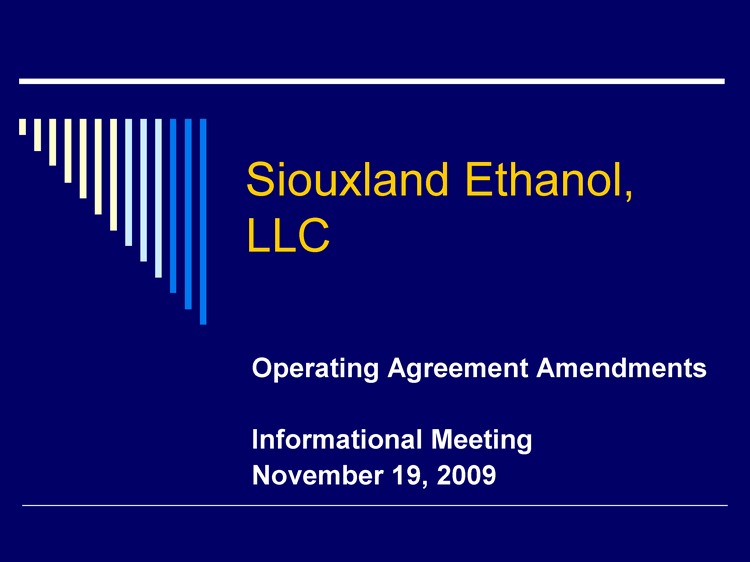
| Siouxland Ethanol, LLC Operating Agreement Amendments Informational Meeting November 19, 2009 |
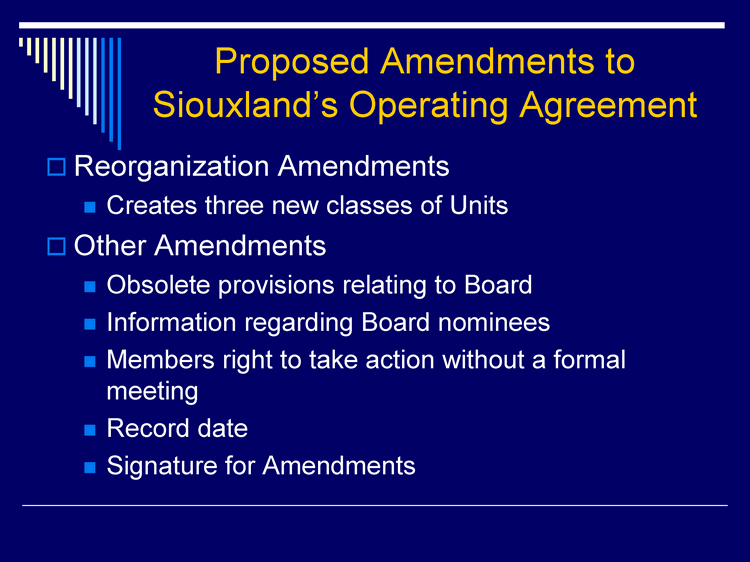
| Proposed Amendments to Siouxland's Operating Agreement Reorganization Amendments Creates three new classes of Units Other Amendments Obsolete provisions relating to Board Information regarding Board nominees Members right to take action without a formal meeting Record date Signature for Amendments |

| Reorganization Amendments Divides the existing single class of Units into Class A Units, Class B Units and Class C Units. Establishes the distinct rights and obligations of these three classes of Units. There must be enough difference in the rights of holders to create separate classes under law. Provides how the new classes of Units will be distributed among members in exchange for existing Units. |
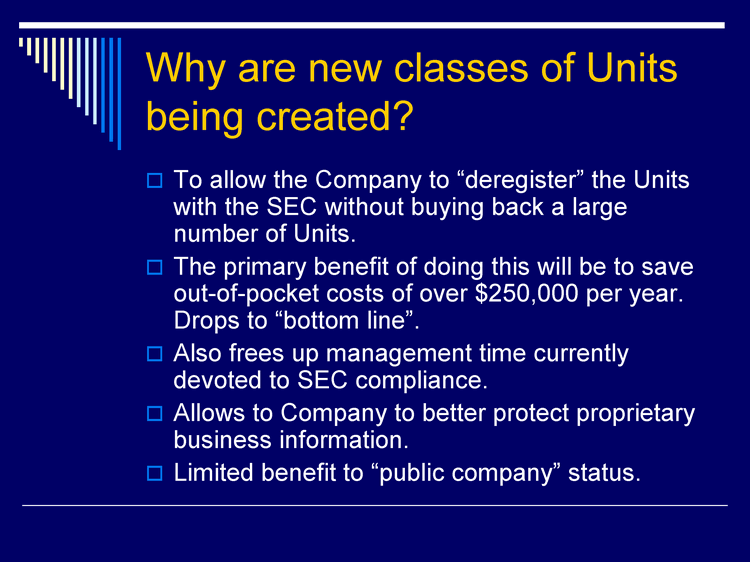
| Why are new classes of Units being created? To allow the Company to "deregister" the Units with the SEC without buying back a large number of Units. The primary benefit of doing this will be to save out-of-pocket costs of over $250,000 per year. Drops to "bottom line". Also frees up management time currently devoted to SEC compliance. Allows to Company to better protect proprietary business information. Limited benefit to "public company" status. |

| How does "deregistration" occur? The existing class of Units (which will become the Class A Units) will be held by less than 300 members. Class B and Class C Units will each be owned by under 500 members. As a result, the Company will no longer have a class of securities that is owned by enough people to be subject to registration with the SEC. Must maintain ownership below these levels or the Company will need to register again. |
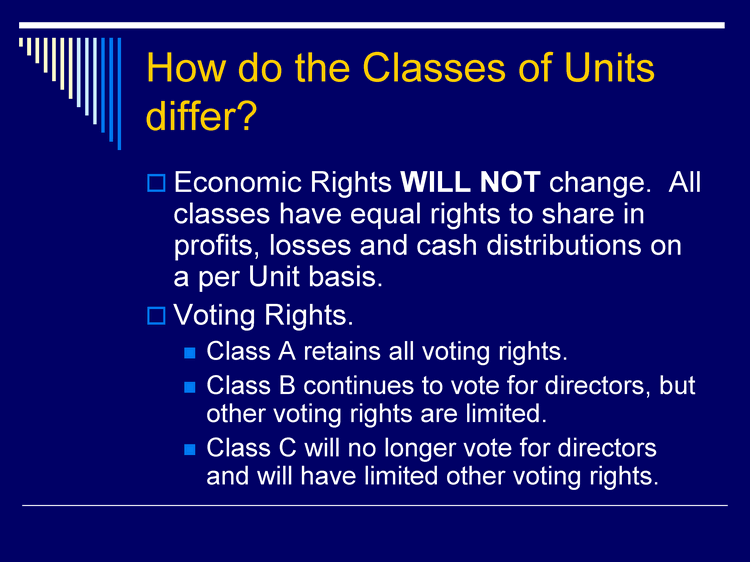
| How do the Classes of Units differ? Economic Rights WILL NOT change. All classes have equal rights to share in profits, losses and cash distributions on a per Unit basis. Voting Rights. Class A retains all voting rights. Class B continues to vote for directors, but other voting rights are limited. Class C will no longer vote for directors and will have limited other voting rights. |

| How do the Classes of Units differ? Transferability Class A Units remain subject to all transfer restrictions, including prior approval of Board in most cases. Class B and Class C no longer require Board approval for transfers. Transfer may be temporarily deferred if necessary to prevent adverse tax results for Company. All Classes are subject to limitations to prevent ownership exceeding the limits to maintain "private Company" status. |
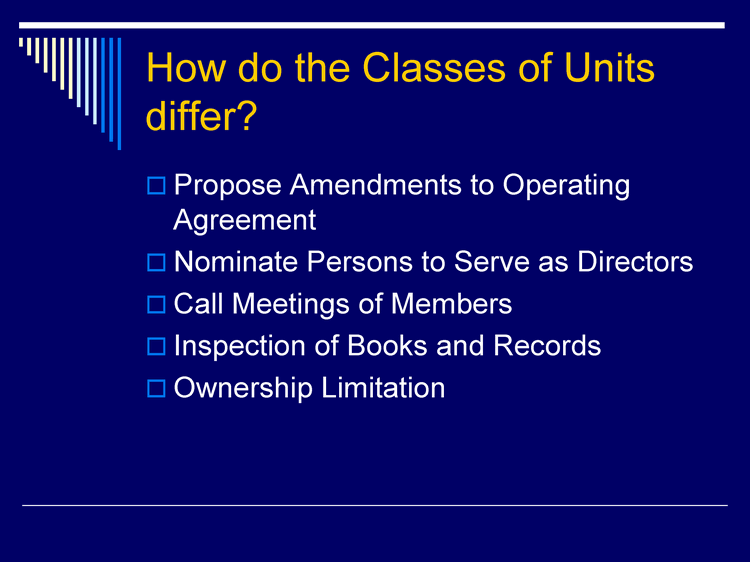
| How do the Classes of Units differ? Propose Amendments to Operating Agreement Nominate Persons to Serve as Directors Call Meetings of Members Inspection of Books and Records Ownership Limitation |
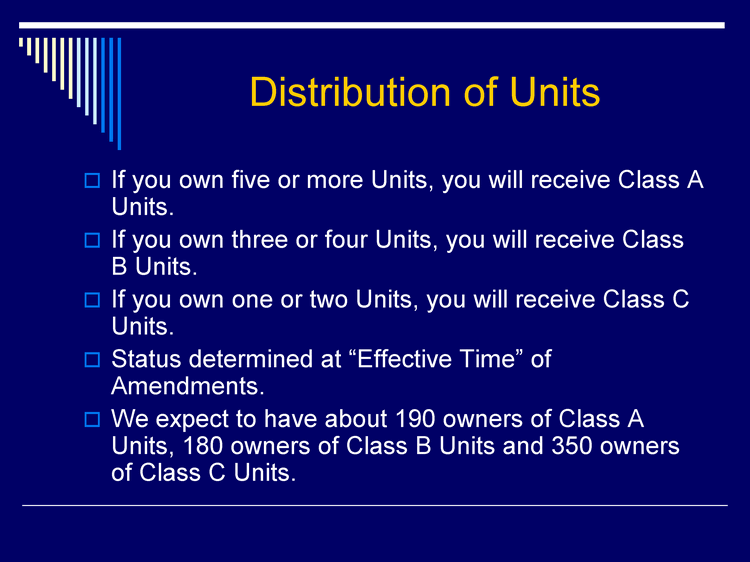
| Distribution of Units If you own five or more Units, you will receive Class A Units. If you own three or four Units, you will receive Class B Units. If you own one or two Units, you will receive Class C Units. Status determined at "Effective Time" of Amendments. We expect to have about 190 owners of Class A Units, 180 owners of Class B Units and 350 owners of Class C Units. |
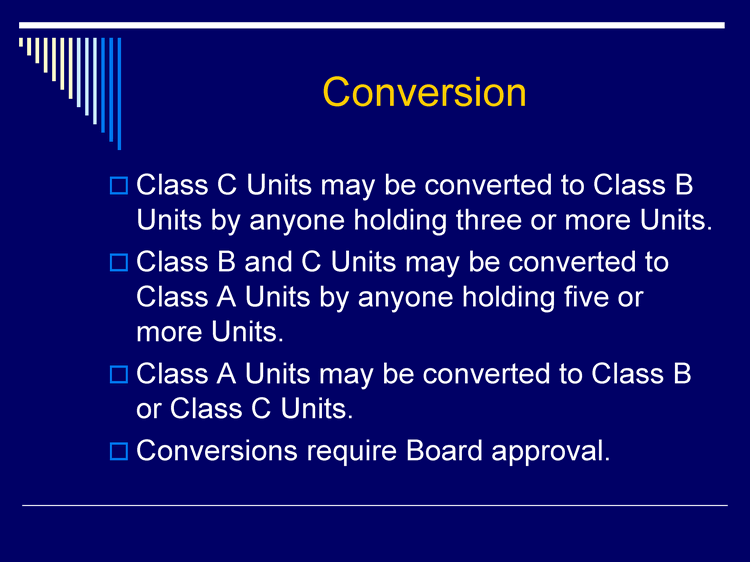
| Conversion Class C Units may be converted to Class B Units by anyone holding three or more Units. Class B and C Units may be converted to Class A Units by anyone holding five or more Units. Class A Units may be converted to Class B or Class C Units. Conversions require Board approval. |
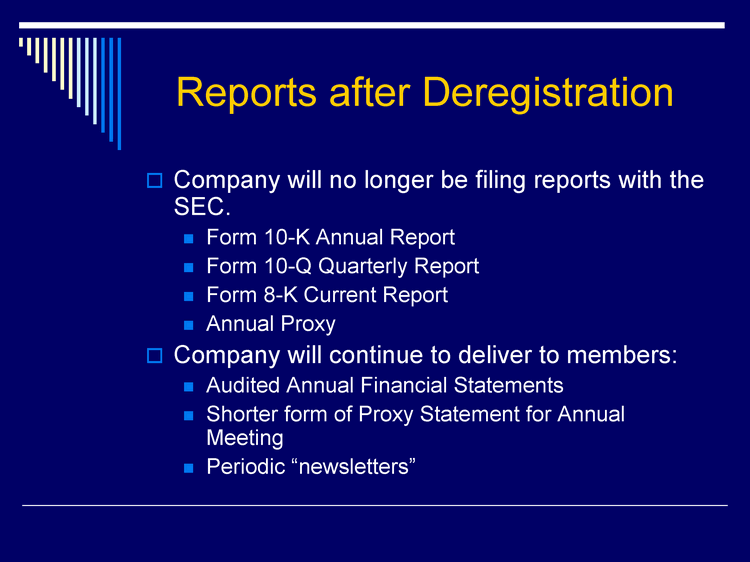
| Reports after Deregistration Company will no longer be filing reports with the SEC. Form 10-K Annual Report Form 10-Q Quarterly Report Form 8-K Current Report Annual Proxy Company will continue to deliver to members: Audited Annual Financial Statements Shorter form of Proxy Statement for Annual Meeting Periodic "newsletters" |
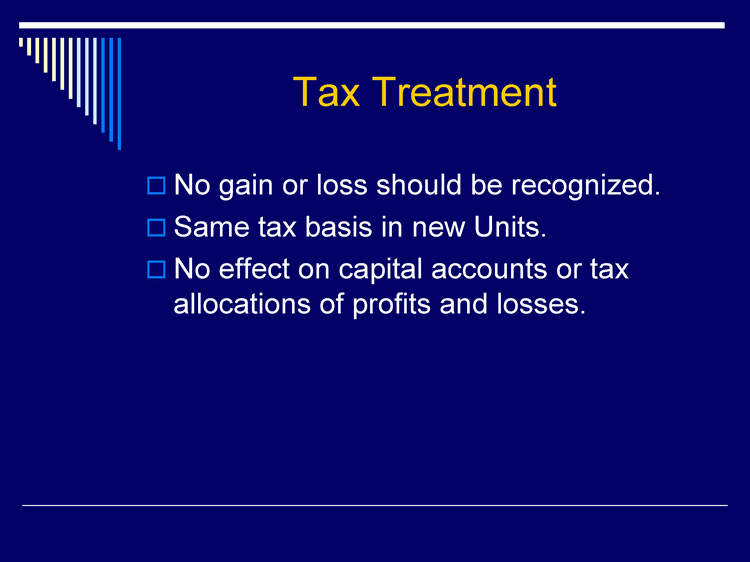
| Tax Treatment No gain or loss should be recognized. Same tax basis in new Units. No effect on capital accounts or tax allocations of profits and losses. |
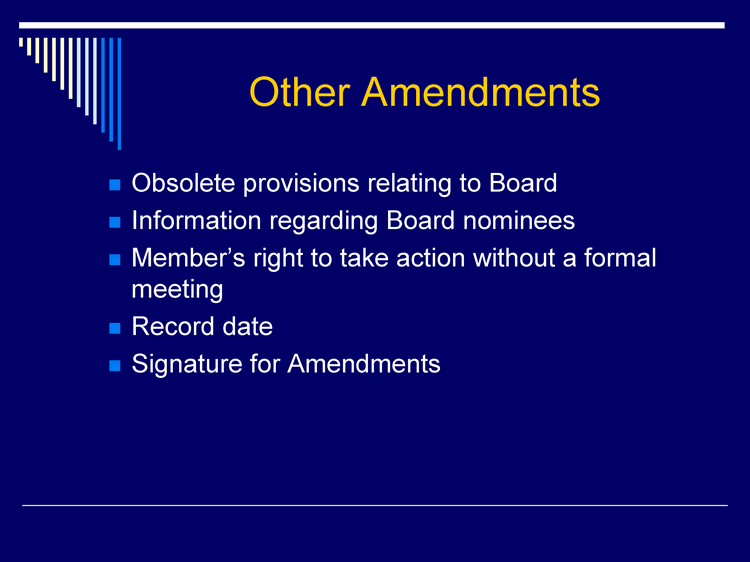
| Other Amendments Obsolete provisions relating to Board Information regarding Board nominees Member's right to take action without a formal meeting Record date Signature for Amendments |
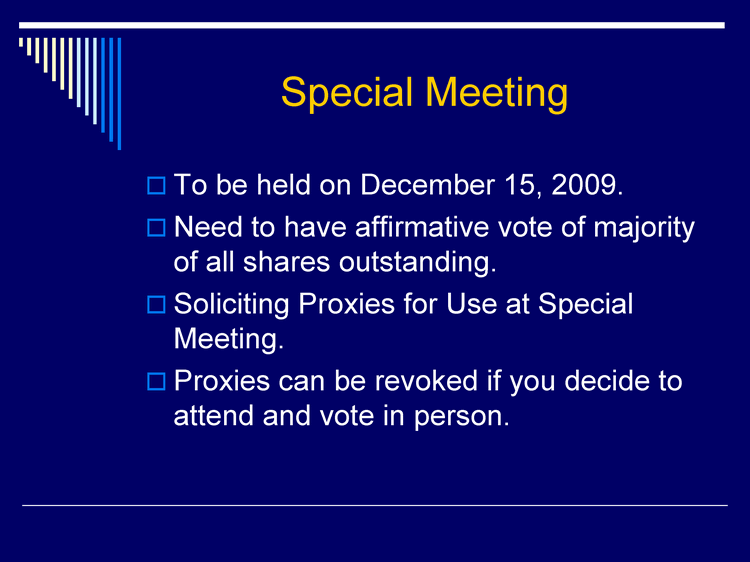
| Special Meeting To be held on December 15, 2009. Need to have affirmative vote of majority of all shares outstanding. Soliciting Proxies for Use at Special Meeting. Proxies can be revoked if you decide to attend and vote in person. |
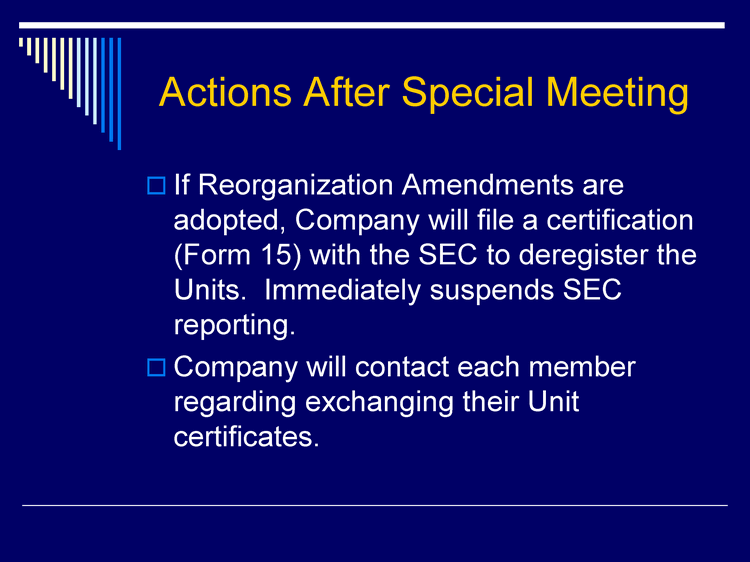
| Actions After Special Meeting If Reorganization Amendments are adopted, Company will file a certification (Form 15) with the SEC to deregister the Units. Immediately suspends SEC reporting. Company will contact each member regarding exchanging their Unit certificates. |
















